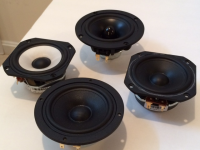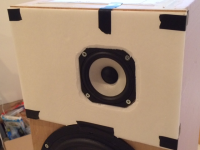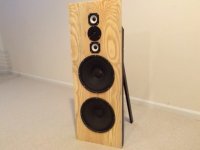Please do not discuss your selection (vote) or what you think the identity of any particular driver is prior to the reveal. Be considerate and allow others to listen and make up their minds without undue influence. It is fine to discuss your process, your thinking and generalities of the driver characteristics. Just avoid labeling Driver X as brand Y etc. If you must prognosticate and want your selections to be recorded for proof of your amazing abilities to pick and name the drivers presented, please do so by creating a text file and uploading that with your post. Add lots of carriage returns to your text file so that the answers are at the bottom and require active mouse movements to reveal the spoiler. Otherwise, an accidental mouse click shows all.
As the 4th installment of the long running saga of blind subjective driver listening tests, this one will be a finale that includes the winner from Rounds 1-3 plus the TG9FD and a secret driver of my choice (from the previous 3 rounds). I have 3 sound clips which were selected based on input and feedback from participants of previous rounds. The sound clips are converted to mono for playback on a solitary speaker, but the sound clips recorded for your listening pleasure are in stereo - to simulate what your stereophonic hearing apparatus perceives if you were actually in my lab auditioning them. You can, of course, at your discretion, convert the recorded sound clips to mono to remove the distraction of the room ambiance.
For those unfamiliar with the routine and specifics, please refer to previous thread on Round 3 and references therein. I will only point out the basics here and major changes to the setup from Round 3:
- FAST using my 10F/RS225 Reference speaker (described in another thread) but with the original full range driver removed and replaced with the driver under test. The rear chamber is a tall 3 sided pyramid or "Dagger" stuffed with fiberglass and has very low - almost zero signature and no signs of "boxyness".
- Drivers under test are fitted with sheets of foam core to permit a flush mounted driver to reduce diffraction in the high frequencies. The offset mounting in a rectangular baffle already reduces the diffraction signifcantly.
- Source tracks are converted to mono on Audacity and saved as .wav files and then three test tracks are burned into a single track on a CD. A Phillips CD player provides the music source via the headphone outs which allow volume adjustment for the miniDSP which drives two Ybdz TPA3116D2 amps with OSCON cap mod and bootstrap snubber mod. The miniDSP is using a Harsch XO set at 350Hz XO frequency. The *only* adjustment made in miniDSP between drivers is adjustment of the level of the full range to normalize for different sensitivities (typical -1dB to -4dB).
- Sound clips are recorded in stereo in 24bit 96kHz .wav files with a Zoom H4 recorder to microSD card. Files are then processed in Audacity to set consistent volume at -0.5dB peak for Clips 1 and 3, and -1dB for Clip 2, then converted to 320kbit 48kHz sampled mp3 files. Files are renamed with .asc extension to allow large file uploads to diyAudio servers. Please change extension back to .mp3 to listen.
- The answer key to the driver identities is provided to two diyAudio moderators in case anyone ever suspects identity tampering following results.
Here are the winners from Rounds 1, 2, and 3:
- Vifa TC9FD18-08 (3.5in paper cone ferrite magnet 8 ohms)
- ScanSpeak 10F/8424G00 (3.5in fiberglass cone Nd magnet 8 ohms)
- Visaton B80 8 ohm (3.5in paper cone Nd magnet 8 ohms)
to this I will add the
- Vifa TG9FD10-08 (3.5in fiberglass cone ferrite magnet 8 ohm version) to allow a fiberglass cone per user requests
And I will also add my secret driver for five total drivers randomly labeled:
A, B, D, E, F (note C is missing because I was going to add two secret drivers but decided against it to keep it lean and fast).
Here is a photo of the 4 drivers (secret one not shown):
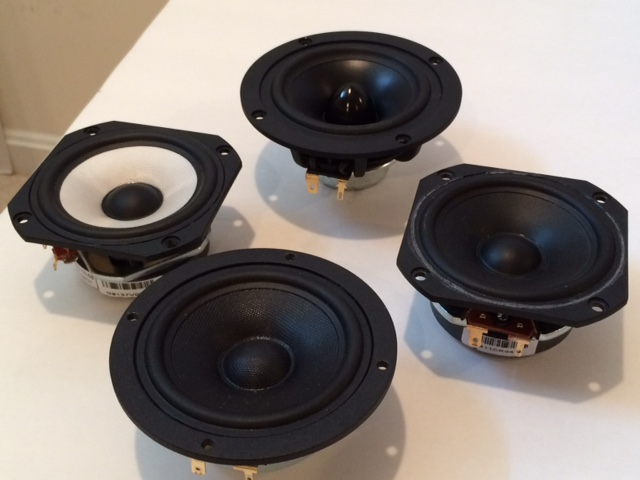
Here is a photo showing detail of the flush mounting rebate with foam core:
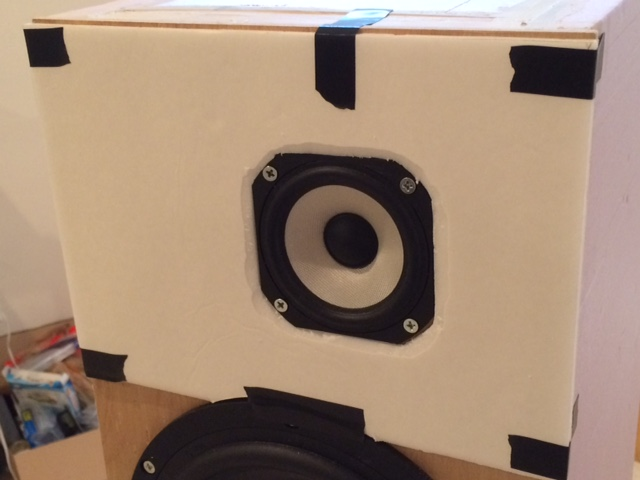
Sound clips to follow... Enjoy and have fun!
Edit (Sept 5, 2015): Adding list of all drivers tested in all 3 rounds leading up to this finale. We are now auditioning and selecting the top 3 (plus 1 that I selected) from a total of 21 drivers. In general, the driver with the flattest response has taken the top spot - so now we are listening to the best of the best in terms of flat frequency response so it is not surprising that it is hard to hear a difference as that is the principal means that our ears differentiate sound voice signature.
Round 1: Winner = TC9FD
1. Vifa TC9FD (3.5in paper cone 8 ohm)
2. Faital Pro 3FE22 (3in paper cone 16 ohm)
3. Dayton Audio RS100-4 (3.5in aluminum cone 4 ohm)
4. Dayton Audio RS100P-4 (3.5inpaper cone 4 ohm)
5. Dayton Audio PS95-8 (3in paper cone 8 ohm)
6. MA CHN-70 (4in paper cone 8 ohm)
7. PRV 5MR450NDY (5in 'midrange' pro audio paper cone 8 ohm)
Round 2: Winner = 10F/8424
8. Vifa TG9FD10-8 (fiberglass cone)
9. Tang Band W4-1320SB (paper cone)
10. Peerless P830986 (aluminum cone)
11. Fostex FF105WK (paper cone)
12. ScanSpeak 10F/8424G00 (fiberglass cone)
13. Mark Audio Alpair A7.3 (silver cone) (aluminum cone)
14. AHE 3in (from Taiwan) (paper cone) http://m.ruten.com.tw/goods/show.php?g=21206258966085
Round 3: Winner = B80
15. SB Accoustics SB65WBAC25-4 (2.5in aluminum cone Nd magnet)
16. Peerless P830983 (2in aluminum cone Nd magnet)
17. Tang Band W3-1364SA (3in bamboo cone Nd magnet)
18. GR Research LGK (3in paper cone ferrite magnet)
19. Mark Audio Alpair A7P (4in paper cone ferrite magnet)
20. Visaton B80 (3.5in paper cone Nd magnet)
21. Visaton FRS5X (8ohm 2in paper cone ferrite magnet)
*REPEAT* Mark Audio Alpair A7.3 (aluminum cone ferrite magnet - previously tested in Round 2)
Edit (Sept. 5, 2015, 2150EDT): Level matched reference sound clips are available here LINK in case you want an easy to compare reference track that is at about the same volume as the test clips.
Edit Sept. 15, 2015: Reveal is here.
As the 4th installment of the long running saga of blind subjective driver listening tests, this one will be a finale that includes the winner from Rounds 1-3 plus the TG9FD and a secret driver of my choice (from the previous 3 rounds). I have 3 sound clips which were selected based on input and feedback from participants of previous rounds. The sound clips are converted to mono for playback on a solitary speaker, but the sound clips recorded for your listening pleasure are in stereo - to simulate what your stereophonic hearing apparatus perceives if you were actually in my lab auditioning them. You can, of course, at your discretion, convert the recorded sound clips to mono to remove the distraction of the room ambiance.
For those unfamiliar with the routine and specifics, please refer to previous thread on Round 3 and references therein. I will only point out the basics here and major changes to the setup from Round 3:
- FAST using my 10F/RS225 Reference speaker (described in another thread) but with the original full range driver removed and replaced with the driver under test. The rear chamber is a tall 3 sided pyramid or "Dagger" stuffed with fiberglass and has very low - almost zero signature and no signs of "boxyness".
- Drivers under test are fitted with sheets of foam core to permit a flush mounted driver to reduce diffraction in the high frequencies. The offset mounting in a rectangular baffle already reduces the diffraction signifcantly.
- Source tracks are converted to mono on Audacity and saved as .wav files and then three test tracks are burned into a single track on a CD. A Phillips CD player provides the music source via the headphone outs which allow volume adjustment for the miniDSP which drives two Ybdz TPA3116D2 amps with OSCON cap mod and bootstrap snubber mod. The miniDSP is using a Harsch XO set at 350Hz XO frequency. The *only* adjustment made in miniDSP between drivers is adjustment of the level of the full range to normalize for different sensitivities (typical -1dB to -4dB).
- Sound clips are recorded in stereo in 24bit 96kHz .wav files with a Zoom H4 recorder to microSD card. Files are then processed in Audacity to set consistent volume at -0.5dB peak for Clips 1 and 3, and -1dB for Clip 2, then converted to 320kbit 48kHz sampled mp3 files. Files are renamed with .asc extension to allow large file uploads to diyAudio servers. Please change extension back to .mp3 to listen.
- The answer key to the driver identities is provided to two diyAudio moderators in case anyone ever suspects identity tampering following results.
Here are the winners from Rounds 1, 2, and 3:
- Vifa TC9FD18-08 (3.5in paper cone ferrite magnet 8 ohms)
- ScanSpeak 10F/8424G00 (3.5in fiberglass cone Nd magnet 8 ohms)
- Visaton B80 8 ohm (3.5in paper cone Nd magnet 8 ohms)
to this I will add the
- Vifa TG9FD10-08 (3.5in fiberglass cone ferrite magnet 8 ohm version) to allow a fiberglass cone per user requests
And I will also add my secret driver for five total drivers randomly labeled:
A, B, D, E, F (note C is missing because I was going to add two secret drivers but decided against it to keep it lean and fast).
Here is a photo of the 4 drivers (secret one not shown):

Here is a photo showing detail of the flush mounting rebate with foam core:

Sound clips to follow... Enjoy and have fun!
Edit (Sept 5, 2015): Adding list of all drivers tested in all 3 rounds leading up to this finale. We are now auditioning and selecting the top 3 (plus 1 that I selected) from a total of 21 drivers. In general, the driver with the flattest response has taken the top spot - so now we are listening to the best of the best in terms of flat frequency response so it is not surprising that it is hard to hear a difference as that is the principal means that our ears differentiate sound voice signature.
Round 1: Winner = TC9FD
1. Vifa TC9FD (3.5in paper cone 8 ohm)
2. Faital Pro 3FE22 (3in paper cone 16 ohm)
3. Dayton Audio RS100-4 (3.5in aluminum cone 4 ohm)
4. Dayton Audio RS100P-4 (3.5inpaper cone 4 ohm)
5. Dayton Audio PS95-8 (3in paper cone 8 ohm)
6. MA CHN-70 (4in paper cone 8 ohm)
7. PRV 5MR450NDY (5in 'midrange' pro audio paper cone 8 ohm)
Round 2: Winner = 10F/8424
8. Vifa TG9FD10-8 (fiberglass cone)
9. Tang Band W4-1320SB (paper cone)
10. Peerless P830986 (aluminum cone)
11. Fostex FF105WK (paper cone)
12. ScanSpeak 10F/8424G00 (fiberglass cone)
13. Mark Audio Alpair A7.3 (silver cone) (aluminum cone)
14. AHE 3in (from Taiwan) (paper cone) http://m.ruten.com.tw/goods/show.php?g=21206258966085
Round 3: Winner = B80
15. SB Accoustics SB65WBAC25-4 (2.5in aluminum cone Nd magnet)
16. Peerless P830983 (2in aluminum cone Nd magnet)
17. Tang Band W3-1364SA (3in bamboo cone Nd magnet)
18. GR Research LGK (3in paper cone ferrite magnet)
19. Mark Audio Alpair A7P (4in paper cone ferrite magnet)
20. Visaton B80 (3.5in paper cone Nd magnet)
21. Visaton FRS5X (8ohm 2in paper cone ferrite magnet)
*REPEAT* Mark Audio Alpair A7.3 (aluminum cone ferrite magnet - previously tested in Round 2)
Edit (Sept. 5, 2015, 2150EDT): Level matched reference sound clips are available here LINK in case you want an easy to compare reference track that is at about the same volume as the test clips.
Edit Sept. 15, 2015: Reveal is here.
Attachments
Last edited:
Running them wideband as a subjective comparison test has some value, but then there's the issue of how you would actually use them in a multi-way system.
The thing I like about the TG9 (which I have many of) is that it makes it easy to avoid having a crossover point between 500HZ and 16kHZ, which gives a very nice stereo effect. If you want more off axis response at the high end, you can always put in a tweeter to handle above 7kHZ. Due to inter-aural crosstalk confusing the imaging cues below about 1kHZ, most stereo effect seems to be a product of the matching of the two sides between about 800HZ and 6kHZ. A very great speaker system IMO would be a hard cone (Kevlar or ?) 8 inch woofer crossed to the TG9 at 500 HZ, with an active 4 pole (bi-amp'd) (which is what I built and am very happy with)(once you've got a chassis with an active crossover, it's easy to add low bass active EQ too, which is a huge plus IMO). I find that I don't mind the limited off-axis treble of the TG9. An abrupt off axis change in FR due to a crossover point being around 2-4kHZ would be worse IMO. If the woofer had a PP cone, you could even do well with a one pole passive crossover. It doesn't get much simpler than that.
Sorry to be a little off subject here.
The thing I like about the TG9 (which I have many of) is that it makes it easy to avoid having a crossover point between 500HZ and 16kHZ, which gives a very nice stereo effect. If you want more off axis response at the high end, you can always put in a tweeter to handle above 7kHZ. Due to inter-aural crosstalk confusing the imaging cues below about 1kHZ, most stereo effect seems to be a product of the matching of the two sides between about 800HZ and 6kHZ. A very great speaker system IMO would be a hard cone (Kevlar or ?) 8 inch woofer crossed to the TG9 at 500 HZ, with an active 4 pole (bi-amp'd) (which is what I built and am very happy with)(once you've got a chassis with an active crossover, it's easy to add low bass active EQ too, which is a huge plus IMO). I find that I don't mind the limited off-axis treble of the TG9. An abrupt off axis change in FR due to a crossover point being around 2-4kHZ would be worse IMO. If the woofer had a PP cone, you could even do well with a one pole passive crossover. It doesn't get much simpler than that.
Sorry to be a little off subject here.
Last edited:
Bob Richards,
All of these drivers can work well in a FAST with a XO between 300Hz and 500Hz. Higher frequency XO will reduce distortion due to smaller cone motion. Some of these drivers can actually even hit 20kHz. I agree that the TG9FD (and the 10F) work superbly as a wide band mid in a 3-way or 4-way system. I have used the TG9FD in a 3 way with silk dome tweeter and a 12in pro audio woofer on the bottom. Super clean detailed sound that is smooth and crisp. This was the "B&O Hole Filler XO"
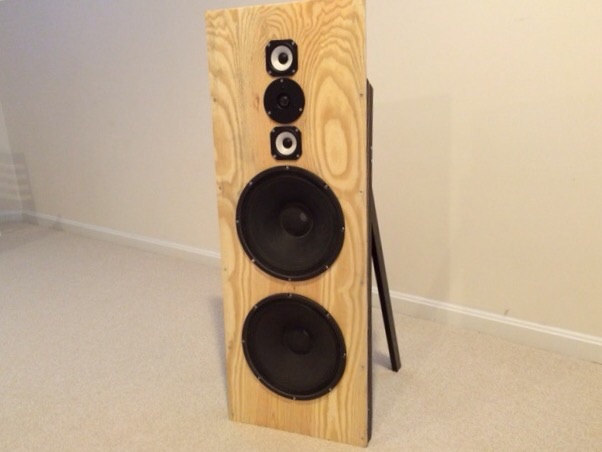
Look at the bandwidth that the TG9FD had to cover with a 1st order filter on either side:
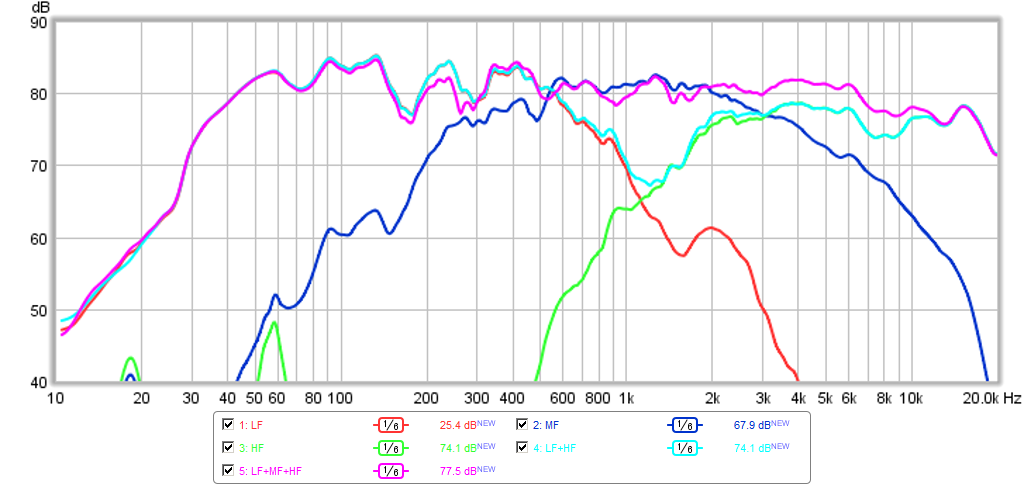
But doing this yields a clean impulse:
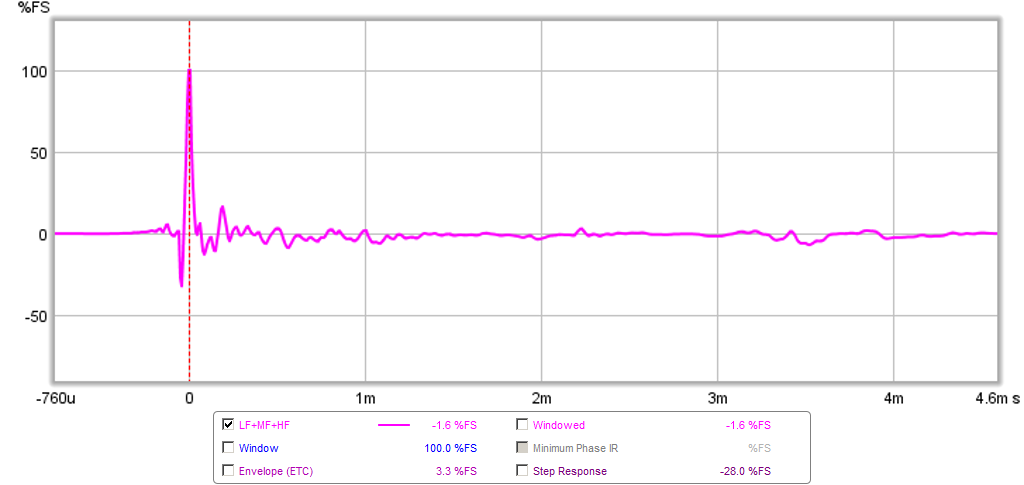
And transient perfect behavior with a right triangle shaped Step Response:
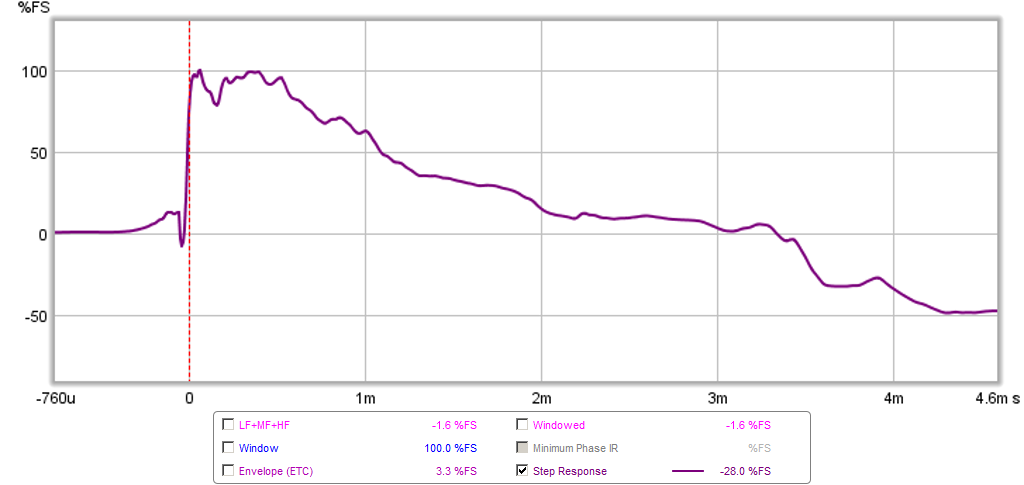
More info here:
http://www.diyaudio.com/forums/multi-way/88135-filler-driver-ala-b-o-12.html#post4382967
All of these drivers can work well in a FAST with a XO between 300Hz and 500Hz. Higher frequency XO will reduce distortion due to smaller cone motion. Some of these drivers can actually even hit 20kHz. I agree that the TG9FD (and the 10F) work superbly as a wide band mid in a 3-way or 4-way system. I have used the TG9FD in a 3 way with silk dome tweeter and a 12in pro audio woofer on the bottom. Super clean detailed sound that is smooth and crisp. This was the "B&O Hole Filler XO"

Look at the bandwidth that the TG9FD had to cover with a 1st order filter on either side:

But doing this yields a clean impulse:

And transient perfect behavior with a right triangle shaped Step Response:

More info here:
http://www.diyaudio.com/forums/multi-way/88135-filler-driver-ala-b-o-12.html#post4382967
Attachments
Last edited:
XRK
Would please post a new round-clip-1-ref.asc.. It is much louder than the provided sound clips. Thanks in advance
I applied -4.2dB to Clip 1 to get it to a level that is about same as the recorded clips.
This higher level used in the source music playing from the CD. All I did was extract the file that was on the CD and converted to mp3. Perhaps the source music was more compressed with less difference between the valleys and the peaks.
Here is the modified ref trip with similar gain.
Attachments
was there any fostex's in the tests?
Yes. Round 1 had FF105WK.
- Home
- Loudspeakers
- Full Range
- A Subjective Blind Comparison of 2in to 4in drivers - Round 4
